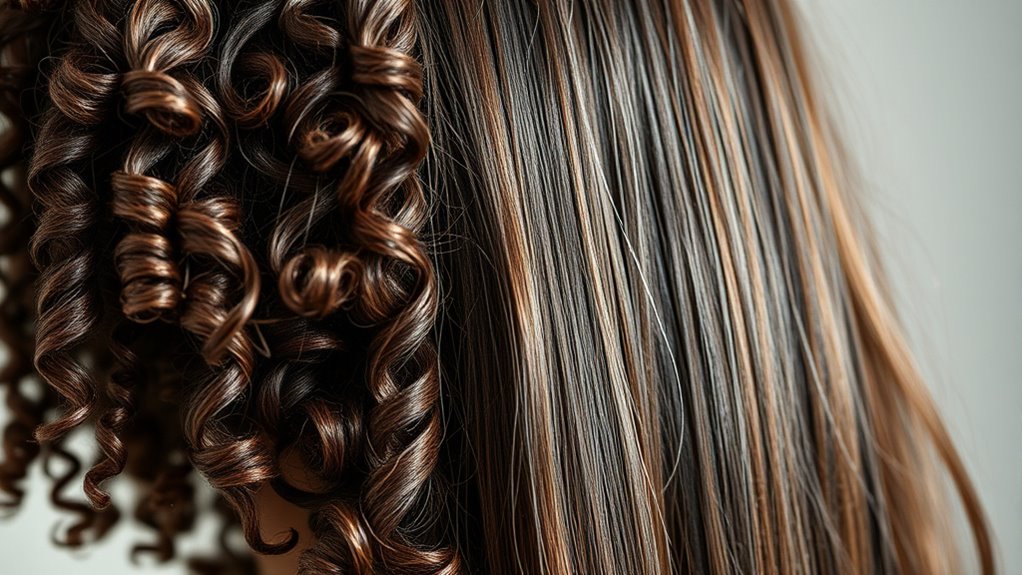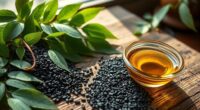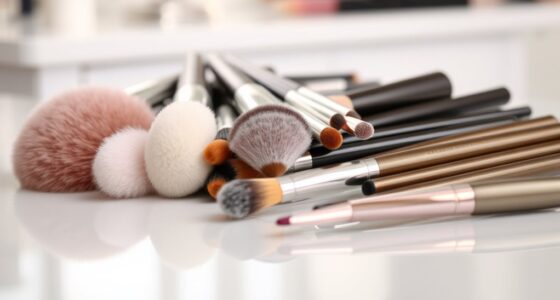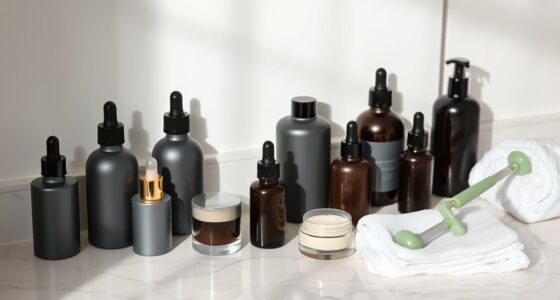Understanding your hair’s porosity helps you choose the right products and routines to keep your hair healthy, shiny, and well-moisturized. You might have low, medium, or high porosity hair, each with unique traits. Knowing your porosity allows you to prevent damage, reduce frizz, and improve styling results. By exploring how to identify your type and care for it, you’ll discover simple tips that can transform your hair’s health and appearance.
Key Takeaways
- Determine your hair porosity by performing a simple water test or observing how it absorbs moisture and products.
- Understand the characteristics of low, medium, and high porosity to identify your hair type accurately.
- Tailor your hair care routine and product choices based on your porosity level for optimal moisture retention and health.
- Use appropriate treatments, like heat or protein masks, to strengthen or hydrate your specific hair porosity.
- Regularly assess and adjust your routine to maintain healthy, shiny hair suited to your porosity type.
What Is Hair Porosity and Why Does It Matter?
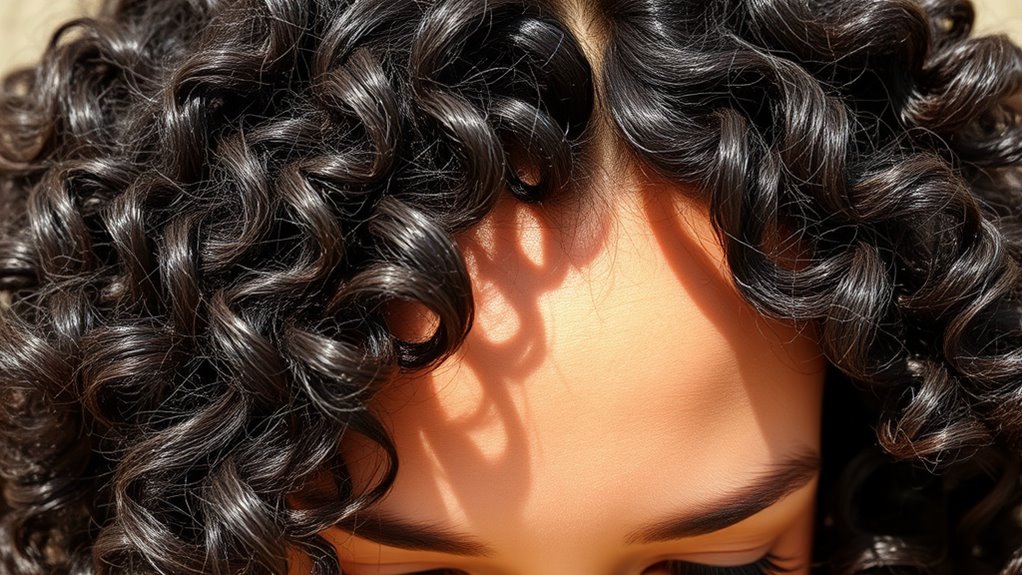
Understanding hair porosity is essential because it directly affects how your hair absorbs and retains moisture. Many hair porosity myths circulate, leading people to misunderstand their hair’s needs. Some believe that high porosity means damaged hair, but that’s a hair porosity myth—your hair might be naturally porous. Conversely, low porosity isn’t always better; it can make moisture absorption difficult. Knowing your hair’s porosity helps you choose the right products and routines, preventing damage and promoting healthy hair. Recognizing what’s true and what’s not allows you to tailor your hair care routine effectively, ensuring your hair stays healthy, shiny, and well-moisturized. Self Watering Plant Pots can serve as a useful analogy for understanding how moisture retention and absorption work in hair care routines.
Types of Hair Porosity Explained
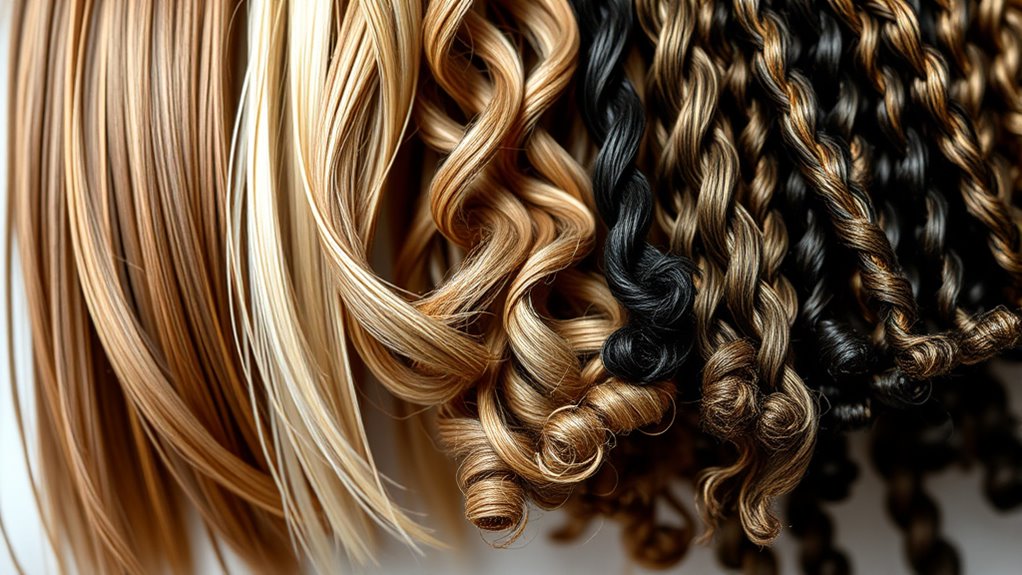
Understanding the different types of hair porosity helps you choose the right products and care routines. Low porosity hair resists moisture absorption, while medium porosity maintains a good balance. High porosity hair easily absorbs and loses moisture, making it more prone to damage.
Low Porosity Characteristics
Low porosity hair tends to resist moisture absorption because its cuticles are tightly closed, making it harder for water and products to penetrate. This means your hair often feels shiny and smooth but can also be prone to product buildup. When applying hair dye, it may take longer to process, and color might not develop evenly without extra effort. Maintaining scalp health can be challenging since buildup can clog follicles, leading to dryness or itchiness. Visualize your hair as:
- A tightly sealed barrier that repels water and oils
- A surface that resists quick product absorption, requiring warm or heat treatments
- An environment where scalp buildup easily accumulates if not properly cleansed
Understanding these traits helps you tailor your routine, ensuring your low porosity hair stays healthy, vibrant, and easy to manage. Recognizing that hair porosity can influence dog breed suitability might help you better understand how your hair type impacts your overall hair care approach.
Medium Porosity Traits
Medium porosity hair typically absorbs moisture and products more easily than low porosity hair, making it the most manageable type. You’ll find that it holds styles well and responds predictably to treatments like conditioning or styling products. When it comes to hair dye, medium porosity hair usually colors evenly and retains the color longer, reducing the risk of uneven tones. However, because the cuticles are more open than low porosity hair, your scalp might be more sensitive to certain chemicals or dyes, so always perform a patch test before coloring. Proper care helps maintain its balance, preventing over-processing or damage. Additionally, using appropriate essential oils in hair treatments can enhance scalp health and promote a healthy shine. Overall, medium porosity hair offers a good mix of manageability and responsiveness, making it ideal for a variety of styling and treatment routines.
High Porosity Features
What exactly are the features of high porosity hair? You’ll notice that it absorbs moisture quickly but also loses it just as fast. Your hair might feel coarse or wiry, and it often appears damaged or frizzy. Because the cuticles are raised or broken, color from hair dyeing doesn’t last long, leading to frequent touch-ups. High porosity hair is also more prone to scalp issues, like dryness or irritation, due to its inability to retain scalp oils effectively. You might see:
- Rapid moisture absorption and quick dehydration
- Frizz and flyaways even after styling
- Difficulty maintaining color and scalp health
Recognizing these traits helps you tailor your care routine to strengthen your hair and protect your scalp. Automation technologies can assist in developing personalized hair care solutions that adapt to different porosity levels.
How to Test Your Hair’s Porosity at Home

Testing your hair’s porosity at home is simple and doesn’t require any special tools. You can do a quick DIY testing method by taking a few strands of clean, dry hair and dropping them into a glass of water. Wait for about 3-4 minutes. If the hair sinks quickly, your hair likely has high porosity; if it floats, it’s probably low porosity. Additionally, you can use basic hair porosity tools like a porosity tester or slide a strand between your fingers to feel the cuticle’s openness. These tools help give a clearer picture of your hair’s porosity. Remember, this at-home test isn’t definitive but offers a helpful starting point for understanding your hair’s needs and choosing the right care routine. Proper understanding of hair porosity can also guide you in selecting suitable hair products and treatments for optimal health.
Characteristics of High Porosity Hair
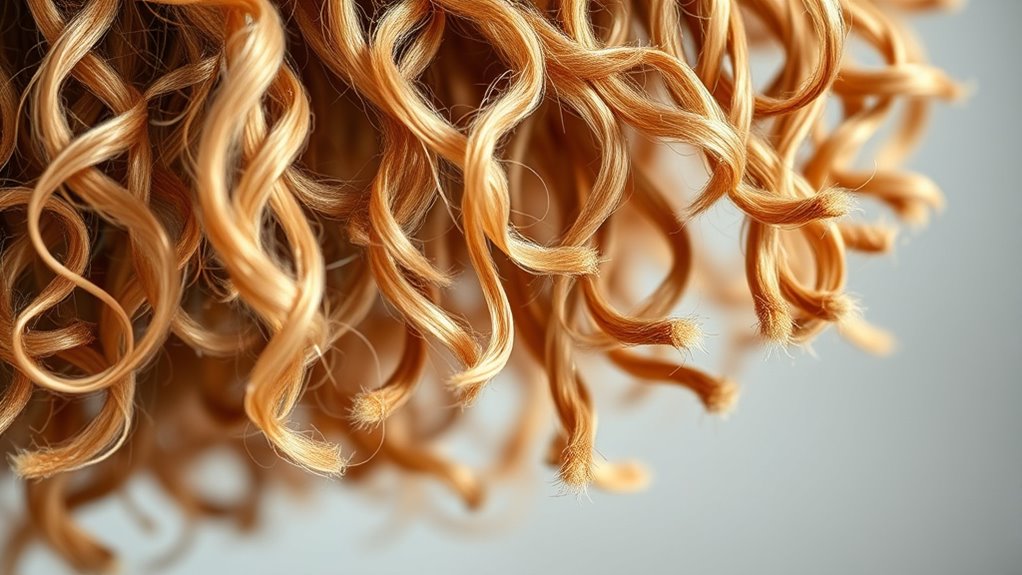
High porosity hair often struggles to retain moisture, leaving your strands dry and brittle. You might notice increased damage and breakage because the cuticles are more prone to fraying. Styling can also be tricky, as your hair may become frizzy or lose its shape easily.
Moisture Retention Challenges
Because their cuticles are often raised or damaged, high porosity hair struggles to retain moisture effectively. You may notice your hair quickly loses hydration, leaving it dry, brittle, and prone to frizz. This affects your scalp health too, as dry scalp can lead to irritation or dandruff. With hair porosity being high, moisture escapes easily through the gaps in your cuticles. Visualize:
- Water slipping off your strands like oil on a hot skillet
- Moisture penetrating quickly but evaporating just as fast
- Your hair feeling parched despite regular hydration efforts
This constant moisture loss makes it challenging to keep your hair soft and shiny. To combat these issues, you need targeted care that helps lock in moisture and restore your scalp health. Understanding hair porosity can guide you in choosing the right products and routines for your hair type.
Damage and Breakage
Have you noticed your hair feeling weak, breaking easily, or developing split ends? These are common signs of damage in high porosity hair. Because your cuticles are often raised or broken, moisture escapes quickly, leaving your strands brittle and prone to breakage. This damage can make your hair look dull and cause split ends to form more readily. Poor scalp health can also contribute to breakage, as a compromised scalp doesn’t provide a healthy foundation for hair growth. To combat this, focus on strengthening treatments, gentle handling, and maintaining scalp health. Regular trims help prevent split ends from traveling up the strand, while moisturizing products seal the cuticle to reduce further damage. Understanding toilet maintenance and repairs can also help prevent additional hair damage caused by plumbing issues or leaks that lead to excess moisture exposure. Taking these steps can help improve your hair’s resilience and overall appearance.
Styling Difficulties
Styling high porosity hair can be challenging because it tends to absorb moisture quickly and lose it just as fast, making your styles less predictable and more difficult to hold. You might notice your curls falling flat or frizz taking over shortly after styling. Chemical treatments can further weaken your hair, increasing the risk of breakage and making styling even more tricky. Additionally, scalp conditions such as dryness or irritation can interfere with product application and hold. Visualize:
- Frizzy, flyaway strands that refuse to stay in place
- Curls that lose shape within hours
- Products that sit unevenly or slide off easily
To combat these issues, you need moisture-locking products and gentle handling. Proper care helps your styles last longer and keeps your scalp healthy. Incorporating natural language processing (NLP) techniques can also assist in analyzing your hair needs to customize effective care routines.
Traits of Low Porosity Hair
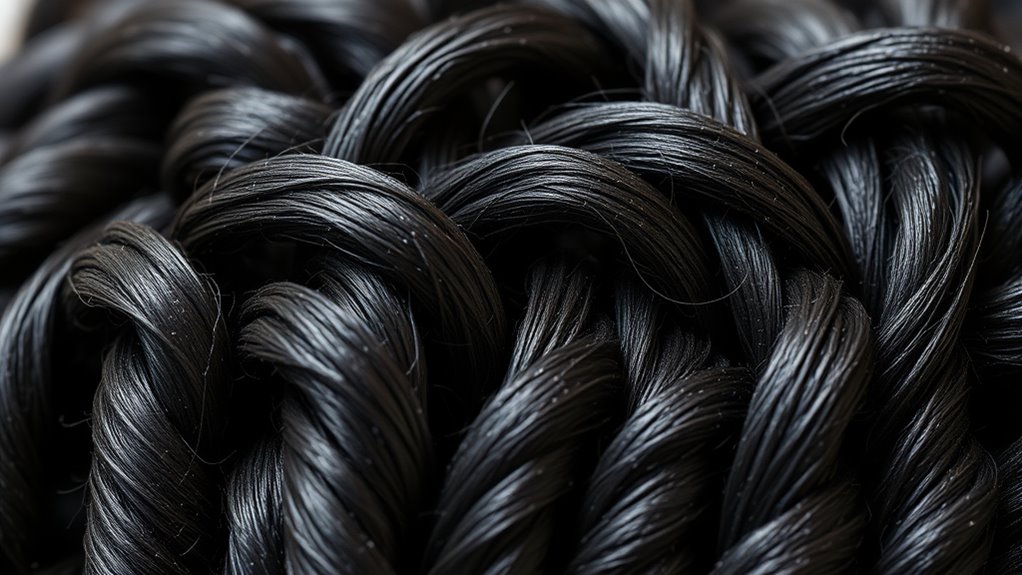
Low porosity hair tends to resist moisture absorption, making it challenging for products to penetrate the hair shaft. This means your hair often feels coated or weighed down, resistant to water and styling products. It may take longer to see results from moisturizing routines, and excess product can build up easily. Your hair might also appear shiny but feel rough or dry after washing. Recognizing these traits helps you adapt your hair care routine for better hair absorption and moisture retention. Being aware of hair porosity can guide you in choosing the right products and techniques to improve your hair health.
Caring for Medium Porosity Hair
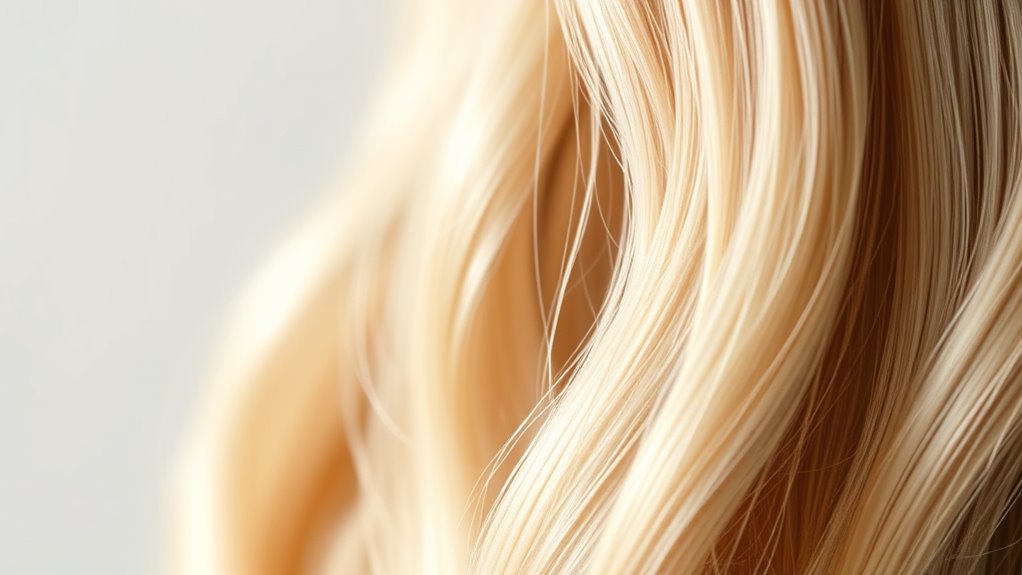
Medium porosity hair strikes a balance, absorbing moisture efficiently while also retaining it well. To care for it, focus on maintaining scalp health and supporting hair density. Regular gentle cleansing prevents product buildup, keeping your scalp healthy and promoting ideal hair growth. Use lightweight conditioners that hydrate without weighing hair down, ensuring your strands stay lively and full. Incorporate protein treatments occasionally to strengthen your hair from root to tip, supporting density. Avoid excessive heat styling, which can damage the cuticle and disrupt moisture balance. Keep your scalp clean and well-moisturized, encouraging healthy follicle function. Visualize soft, bouncy strands with a natural shine, feeling resilient and full of life. Proper care helps your medium porosity hair stay vibrant, healthy, and easy to manage. Additionally, choosing the right hair care products formulated for medium porosity can optimize your routine and enhance overall hair health.
Tips to Maintain and Improve Your Hair’s Health Based on Porosity
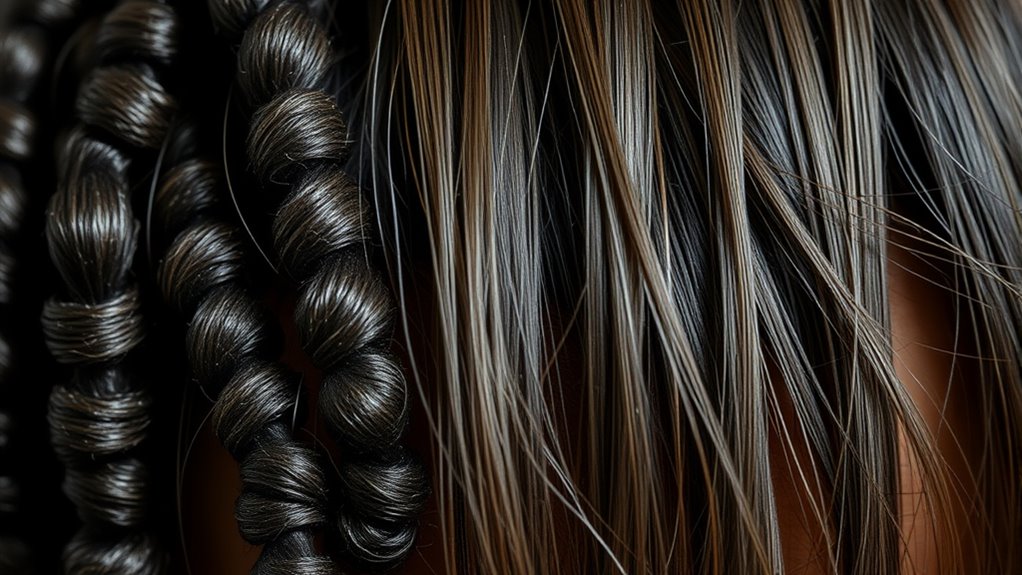
Understanding your hair’s porosity is key to maintaining and improving its health. Once you know your porosity level, you can tailor your routine with effective DIY treatments and natural remedies. For low porosity hair, use lighter oils like grapeseed or argan oil to prevent buildup, and opt for heat during deep conditioning to open the cuticles. High porosity hair benefits from protein treatments and moisturizing masks made from ingredients like honey, aloe vera, or coconut oil to seal in moisture. Medium porosity hair responds well to a balanced routine of moisturizing and protein treatments. Regularly using DIY remedies suited to your porosity helps strengthen your hair, reduce damage, and enhance shine. Consistent care based on your porosity optimizes your hair’s health and appearance.
Frequently Asked Questions
Can Hair Porosity Change Over Time?
Yes, hair porosity can change over time due to various factors influencing porosity. Environmental conditions, chemical treatments, and overall hair health can cause this evolution. You might notice your hair becoming more or less porous as you age or after specific treatments. Monitoring these changes helps you adjust your hair care routine to maintain healthy hair, ensuring you’re addressing your hair’s current porosity level effectively.
Does Porosity Affect Hair Color Longevity?
Porosity definitely impacts your hair color longevity. If your hair has high porosity, it absorbs dye quickly but also loses pigment faster, leading to quicker hair color fade. Low porosity hair retains color longer because it resists moisture and dye penetration, improving pigment retention. Understanding your hair’s porosity helps you choose the right products and techniques, so you can maintain vibrant, long-lasting color and prevent premature fading.
How Does Porosity Influence Hair Product Choice?
Your hair porosity directly influences your product choices. If your hair has high porosity, it absorbs products quickly but loses moisture fast, so look for lightweight, hydrating products that enhance moisture retention. For low porosity hair, opt for products that can penetrate the cuticle, like heat-activated or lighter formulas, ensuring good product compatibility. Understanding your porosity helps you select products that improve moisture retention and keep your hair healthy.
Is Porosity Linked to Hair Damage or Breakage?
Ever wonder if your porosity makes your hair more prone to damage? It can, because high porosity often leads to moisture loss, weakening your strands and affecting scalp health. Low porosity might trap product buildup, reducing hair elasticity and causing breakage. Understanding your porosity helps you tailor your care, prevent damage, and maintain healthy hair. Isn’t it worth knowing how your porosity influences your hair’s strength and resilience?
Can Hair Porosity Be Improved or Altered Intentionally?
You can improve or alter your hair porosity intentionally with specific porosity treatments. These treatments help balance your hair’s moisture absorption and retention, making it more manageable. By consistently using deep conditioning, protein treatments, and hair strengthening products, you can enhance your hair’s porosity over time. While you can’t drastically change your natural porosity, these proactive steps help optimize your hair’s health, making it softer, shinier, and less prone to damage.
Conclusion
Now that you know your hair’s porosity, you hold the secret to hair perfection! With this knowledge, you can discover hair so stunning, it’ll make everyone stop and stare. Say goodbye to dull, damaged locks and hello to radiant, healthy hair that defies time and gravity. Master your porosity, and watch your hair become the envy of the universe—trust me, it’s that powerful. Your dream hair is just one simple step away!
